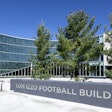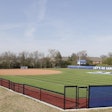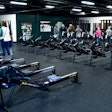A handful of universities are disseminating essential knowledge to today's sports turf professionals and preparing the field for tomorrow's caretakers.
 Photo of researcher answering turf-related questions
Photo of researcher answering turf-related questions
"I can't stand walking out on a field and having the guy say, 'This field looks bad,'" says Rogers. "So I ask, 'Well, when's the last time you mowed it?' He tells me he mows it every two weeks. Then I ask, 'When do you fertilize it?'"
After posing such a question, Rogers usually takes a sports turf manager's subsequent silence to mean that his or her field isn't regularly -- or worse, ever -- fertilized, prompting Rogers to wonder what reasonable chance that turf has been given to succeed, let alone survive.
In many cases, sports turf managers with unhealthy fields can't be blamed for a lack of trying, says Andrew McNitt, an assistant professor of soil science/turfgrass at Penn State University. He says that far too many school districts place unreasonable demands on their fields, but fail to sufficiently equip their sports turf managers to meet those demands. "When I was a kid, junior high sports were played at 3:30 in the afternoon on a practice field. Now these games have to be at 7 o'clock at night, under the lights, in the main stadium," says McNitt, who has spent the past two years of his 20-year career researching and testing infill synthetic-turf systems (see "Synthetic Status Report," p. 94). "More sports -- with soccer, lacrosse and women's programs becoming much more popular -- are being played on one field. There's a limit to how much natural turf can take."
To prevent fields from being pushed past their limits, McNitt says that sports turf managers must be provided with technical information necessary to help them maintain for their fields a balance between maximum usage and optimum performance. "A lot of it comes down to education," he says. "People are beginning to realize that if you want to have quality playing fields, you need a quality person taking care of them."
Serving as the primary sources of that information are a few dozen universities with turfgrass programs that specialize in sports turf management -- although Rogers admits that the phrase "specialize in sports turf management" is open to interpretation. For example, while some schools may have programs that focus exclusively on sports turf management, others may divide resources between that discipline and golf course management. And then there are some universities that only "dabble" in sports turf management -- and by that Rogers means that the full extent of their educational efforts involves being able to answer callers' sports turf questions.
Sports turf management programs are even further broken down by their approach to the discipline: Some are strictly research programs, as is the case with the University of California, Riverside. Most schools (Michigan State, for example) place equal emphasis on research and teaching, offering students two-year certificate and four-year degree programs, as well as opportunities for postgraduate study. And then there are a handful of schools -- Texas A&M, Penn State and Ohio State Universities among them -- that conduct research, train future turf managers and operate extension programs for the benefit of current sports turf professionals.
Because they are responsible for disseminating to managers in the field information gleaned from university sports turf research, extension programs are indispensable to the sports turf industry -- and will become even more so in the future. Rogers credits turf extension specialists at Michigan State for taking virtually any research report and making it "so that somebody can read it, enjoy looking at it and understand it. Those people are worth their weight in gold and we don't have half as many as we need, to be honest. That's the one area that is the most sorely lacking, because that person who's in extension can go out and extend our knowledge. We could save a lot of athletic fields."
Sports turf extension programs extend that knowledge through various channels. On- and off-campus seminars and workshops, conference presentations, online courses, web sites and even informal phone and e-mail conversations are all employed by sports turf extension specialists to spread the good word. Rogers laments the fact that Michigan State doesn't have a staff person devoted exclusively to sports turf; he must rely on general turf extension specialists to release sports turf reports. Fortunately, sports turf faculty at Michigan State and other Big Ten schools can turn to their colleagues at Ohio State University, which has perhaps the most comprehensive sports turf extension web site among those produced by American universities.
The Buckeye Sports Turf Program's research has contributed to much of the site's content, but other schools are also welcome to pitch in. "If there's something at Purdue or any other turf program, we'll highlight those, too," says Ohio State sports turf extension specialist Pamela Sherratt. "We usually provide links. For example, if we do something on poa weed control, we'll link to Purdue because they've done some good research there. We've also done postings on the modular grass field up at Michigan State."
Launched in 2001, the web site (hcs.osu.edu/sports turf) aims to "keep sports field managers abreast of current topics important in the management of athletic fields," and is divided into three main sections: SportsNotes, International SportsNotes and Turf News. SportsNotes features tips that should prove useful to sports turf managers in Ohio and Midwestern states. International SportsNotes boasts content applicable to anyone, anywhere -- relying, in part, on the British-born Sherratt's experiences working on athletic fields in the United Kingdom, as well as on reports filed by an Ohio State turfgrass science professor who regularly visits golf courses and athletic fields in Africa, Asia and Australia. Finally, the Turf News section offers summaries of past and announcements of upcoming Buckeye sports turf events. "I try to put an edition out once a week, but I usually put out between 40 and 50 postings a year," says Sherratt. "Last year, I had 600,000 hits and 20,000 page requests."
Although it currently boasts 2,800 subscribers (mostly college and high school athletic directors and parks and recreation professionals) hailing from 32 states and countries as diverse as Iran, Argentina, Spain, Denmark and England, Ohio State's sports turf web site began as a humble endeavor. "We really started it just to put out weekly messages about timely things that are happening on athletic fields in Ohio," says Sherratt.
Now, sports turf managers worldwide can access brief scientific reports (often accompanied by photos) on topics ranging from drought management to weed control to seed mix. Surprisingly, though, content diversity reportedly isn't subscribers' favorite feature. "We have wondered, 'Should we get it sponsored? Should we charge for this?'" says Sherratt. "But the one comment we get from people is that they really like the fact that the site has independent information. It has not been sponsored by any turf company. And they really like the fact that it's free."
Despite such sites' increasing popularity and usefulness as tools of the trade, travel still makes up a considerable percentage of sports turf extension specialists' job responsibilities. Sherratt averages about 30 visits a year to turf professionals and administrators of school districts and recreation agencies within Ohio's borders. Each spring, she also teaches a "short course" that usually draws about 100 sports turf professionals.
The past five spring semesters, associate professor of turfgrass and extension turfgrass specialist Gwen Stahnke has taught a similar class at the Washington State University Puyallup Research and Extension Center, located an hour's drive south of Seattle. Focusing on environmental issues, the six-week Athletic Field Management course is delivered online and though designed primarily for sports turf professionals in the Seattle area, it is also frequently taken by students on Washington State's Pullman campus 300 miles to the east.
To make up for the lack of their instructor's physical presence, Stahnke's Pullman students supplement their online studies with hands-on learning opportunities, with the help of local sports turf professionals. "I find the course works a lot better when I have somebody in the industry, because they introduce the kids to practical solutions," she says. "I'm trying to get students to understand that networking is very important. It's not just about book learning."
Book learning, however, is becoming increasingly necessary for sports turf professionals. According to Rogers, the fact that today's sports turf job market demands its workers to be better educated than those of previous generations is a realization of the dream the Sports Turf Managers Association founders envisioned for the future of their industry. "You look at people like Harry Gill and George Toma: Great guys, pioneers of the business, no formal education," says Rogers. "But they knew that the next generation must have it."
While graduates from Michigan State's two-year turf management program have a more than favorable shot at landing a decent job right out of school, Rogers says that students in greater numbers are opting to pursue bachelor's, master's and even doctorate degrees to make themselves more attractive to potential employers. Of the 200 students currently enrolled in Michigan State's program (which includes sports turf and golf course management majors), roughly 55 percent are pursuing two-year certificates, 40 percent are on a four-year degree track and 5 percent are graduate students. "Go back 10 years and probably 80 percent were two-year students," says Rogers.
Penn State's turf management program has 240 undergraduates, only 50 of whom are pursuing two-year certificates. In addition, McNitt says that his program has eight or nine graduate students, two of whom are specializing in sports turf management. When those students receive their degrees, McNitt expects them to choose one of several options: they could go into academia, become technical representatives for seed, fertilizer or equipment companies, or take jobs as sports turf specialists with large landscaping companies, which are now marketing all-inclusive maintenance contracts to high schools.
In addition to offering young professionals a greater variety of job prospects, the sports turf industry of the future promises to have a more diverse workforce than ever before. Stahnke's educational and professional experiences illustrate how much things have changed in the past three decades. When she enrolled at the University of Illinois in the early 1970s, "they didn't want women in the horticultural fields, which was really bizarre. I couldn't get into forestry. They told me to take a hike."
Stahnke eventually did break into horticulture the roundabout way, raking bunkers at Urbana Country Club on her way to earning a bachelor's degree in ornamental horticulture. "Then when I got out, I got a job at Medinah Country Club in the Chicago area," she says. "I was the first female to be hired at that golf course. There weren't any other options for women at that point. There weren't really any jobs in the park and rec arena that could pay like mine."
After several years, Stahnke returned to school, earning her master's degree in agronomy from Texas A&M in 1981. Even with those credentials, she encountered skepticism and discrimination from some male students during her three-year tenure as an instructor at Lake City (Fla.) Community College. "I was their first female instructor," recalls Stahnke. "I had a lot of trouble with guys who were younger than me accepting me as a teacher. They didn't want to learn from a female."
Twenty-plus years and a Ph.D. later (including stints as a sod farmer in Atlanta and an agronomist in Milwaukee), Stahnke says the playing field has become much more level. Though one of the first women to earn a doctorate in a horticultural discipline, Stahnke takes comfort in knowing that she is no longer alone. "There are a lot more female Ph.D.s now," she says. "There are a lot of opportunities. I guess I don't think about whether they're for males or females. That doesn't even cross my mind."
However, equal-opportunity issues still occupy the thoughts of Ohio State's Sherratt. "The field is still very male-dominated," she contends. "Very few women and minorities work in this field. That's something we're trying to change."
For starters, Sherratt has relied on the popularity of Ohio State's sports turf web site to draw more attention to those individuals breaking through the industry's gender and color lines. "Erica Titus is one of our female students; I'll highlight her as much as I can," says Sherratt. "I do web postings about her to show how successful she is. She went over to England and worked at Cirencester Polo Club for the Royal Family. That's a good thing about the web site -- I can really highlight our student accomplishments and I hope that they encourage women to come into this area."
It's an uphill battle, though, especially since sports turf manager isn't often a career option that high school guidance counselors share with their students. In spite of being left out of that loop, sports turf management faculty are hosting annual turf field days, during which they open their university research facilities to the general public, and are inviting high school science teachers to bring their students out for personal tours and class experiments. They're even making appearances at off-season coaches' clinics; the past few years, Sherratt has set up a booth at a spring clinic hosted by Buckeyes head football coach Jim Tressel. "I try to showcase some of our students' careers, try to show that they've gone on to work for the Broncos and the Titans and the Boston Red Sox," she says.
Sherratt's goal is not only "to get the message out to kids who love to be around sports and may not be good enough to make the college team," but also to "raise the professionalism of the sports turf industry and show that it is a very viable, wonderful career."
Just how viable? "You're going to have a salary range anywhere from $40,000 to $100,000," says Rogers. "You're not going to starve, but you're not going to drive a Porsche, either. You have a good living and a good environment to work in."
Some sports turf professionals might disagree. Today, demands for high-quality athletic fields -- and the pressures that go with them -- are greater than ever. Youth soccer organizers expect the fields they use to look and perform just as well as those used by professional teams. "We have so much use here," says Stahnke. "Our soccer programs don't end until November and they're back out there in February. There is no time for that grass to grow. They say, 'Get the fields fixed up,' and I tell them, 'Well, your soil temperatures are down to 40 degrees and it's raining. What do you want me to do?' They've really pushed us to the limit."
And while field demand increases, the amount of resources available to sports turf managers remains limited. "I go to some high schools and they won't pay for any type of education for the turf managers, and their kids -- their kids -- are playing on these surfaces," adds Sherratt. "You would think that utmost in people's minds would be field safety. All this money gets spent on equipment and uniforms. Really, the most important thing for the safety of these children is that the field is level and there aren't big holes or anklebreakers in it."
And for all their efforts, in some places sports turf managers still aren't being given their props. Sherratt concedes that "compared to golf course management, sports turf is a relatively new concept. Golf course managers for the past 75, 80 years have really gotten a handle on education, research, extension. They're now seen as professionals -- they're called 'superintendents.'"
But in Sherratt's mind, that doesn't excuse the double standard by which "most of the people I meet who look after high school fields in Ohio are 'custodians,'" she says. "We're trying to send the message that these people are 'superintendents' and 'field managers' and 'head groundskeepers.' We're trying to get away from the 'Groundskeeper Willy' image" of the popular Scottish character on the long-running animated TV satire, "The Simpsons."
Rogers sees a future in which sports turf managers are accorded the same level of respect and professional support as golf course managers. He suggests that school districts, for example, abandon their practice of hiring one turf manager for each school and instead hire that person to take care of fields at all schools in one district. Rogers contends that such a system would also put the workload of sports turf managers on a par with that of golf course superintendents. "You go to a 150-acre golf course and it will have a superintendent," he says. "That superintendent will have an advanced degree. There will be an assistant superintendent, and that assistant will probably have an advanced degree. Then they'll have a crew of anywhere from 10 to 20 workers who do all the maintenance. The superintendent and assistant superintendent decide what chemicals are put down, they decide when everything's done. They answer all the technical questions.
"A person who went out and got that education is going to be looking for things to do. If you give someone fields at a half-dozen schools and the problems that are associated with them, then he or she will get the challenges that he or she is looking for."
University sports turf researchers are looking for all sorts of things these days. At UC Riverside, researchers are studying the makeup of resources -- including, among other things, cash, real property, sod and especially water -- necessary to construct different types of community sports fields, from basic play fields to high-profile premium fields. UC Riverside superintendent of agricultural operations Stephen Cockerham expects his initial report -- "Establishing and Maintaining the Natural Turf Athletic Field," published last year by the University of California, Davis Department of Agriculture and Natural Resources -- to be used by turf managers throughout the parched Southwest. Farther north up the Pacific coast, rainwater is often in abundance. In response, Stahnke and her colleagues at Washington State are working to integrate Kentucky bluegrasses and perennial ryegrasses for use in shady areas on sand-based fields. "We have such low light levels up here and we use the fields year-round," she says. "And we have rain all winter -- which, for us, is actually almost seven months long, from September through July. But people also want drought-tolerant plants. It's a very tricky balance."
University researchers are forging ahead in their quest to help sports turf professionals at high schools, municipal park districts and elsewhere achieve that balance, and thus enable turf managers to meet the high expectations of their end users. Says Rogers: "At the end of the day, who's the winner? The athlete. The athlete has a better field and a safer field."
In Rogers' mind, athletes aren't the only beneficiaries of the work he and his academic colleagues are now conducting on university campuses across the nation. Encouraged by the fact that today's sports turf professionals are receiving better information and greater educational opportunities than their predecessors, Rogers has high hopes for turf managers of the 21st century. "I want somebody to look back and say that we made a difference, that we changed the way people thought about this profession," he says. "And we're going to do it one field at a time."
































